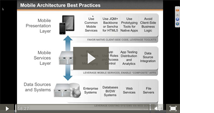
The Role of APIs in Digital Transformation
Organizations of all types and sizes are currently enamored with (or plagued) by a new IT buzzword: Digital Transformation. The cloud, mobile and social network era is indeed affecting the way organizations run their business. Big data and the Internet of Things (IoT) also have firms investing wildly to keep up, or scratching their heads trying to figure out what to do.

What to Consider When Selecting a Platform for IoT App Development
IoT platforms are now entering their adolescence, and the vendor landscape is starting to settle with certain well-defined segments emerging. There are several layers to an IoT platform stack, and corresponding solutions in each, which can help businesses build innovative IoT solutions more efficiently.

Mobility and the Real-Time Enterprise
Digital transformation requires IT organizations to rapidly evolve to support the needs of a real time enterprise. In fact, Gartner estimates that 75 percent of IT organizations will be bi-modal in some way by 2017, however only half will be successful. Furthermore, in a recent survey of IT and business professionals, 78 percent reported their mobile strategies and plans were inhibited or limited by their existing IT environment. Clearly there is a critical gap between what is required to be successful and the reality of the obstacles enterprises are facing. Overcoming those obstacles is the strategic imperative facing large enterprises today.

Modernizing Digital Infrastructure with MBaaS: 2015 and Beyond
As we enter the fascinating world of connected devices everywhere, with apps running on non-traditional endpoints such as appliances, automobiles, and personal clothing, it is imperative for enterprises to enable their developer ecosystems to build solutions that leverage these modern interaction paradigms.

Enterprise Mobile Development Best Practices for 2015
Between Smartphones, tablets and the Internet of Things, development of mobile applications is skyrocketing and shows no sign of slowing down. Architectural options for developing mobile applications are not only numerous but also rapidly evolving. So how can you keep up with this ever-changing landscape?

Agile IT: Modern Architecture for Rapid Mobile App Development
Ignoring mobility in the enterprise is no longer an option but most companies’ mobile strategy is still opportunistic in nature. Apps are deployed on a one-off basis and lack common governance around user experience, security and user policy. This absence of a common mobile infrastructure hinders innovation and cross-disciplinary collaboration. To accelerate mobility maturity in the enterprise, companies must implement a modern app architecture for rapid app development.

Best Practices for API Adoption
APIs have become ubiquitous and they have profoundly changed the way we connect to the world. They have opened the doors to enterprise back-end infrastructure and made it possible for developers to build innovative mobile applications. But this IT revolution comes with its share of challenges. “If we build it they will come” is no longer an effective API launch strategy. AnyPresence and WIP Factory are joining forces to share valuable best practices on improving API adoption.

Why Your Mobile Strategy is Stalling, and How to Fix it
According to a recent survey by Accenture, only two out of five C-level executives reported good progress in their mobility efforts, and just one in ten reported more than 100 percent return on their mobility investment in the last two years. As companies work to mobilize their business and to “appify” key employee audiences and processes, they face many strategic, architectural, and development hurdles.

Mobile-Enabling Enterprise APIs: A Case Study with MasterCard
Most companies have a product, service or some content that they made accessible via the web. But in today’s mobile-first world, it’s becoming clear that enterprise developers need to build apps that use APIs everywhere, from smartphones to tablets and the emerging internet of things. To accelerate the development of apps that incorporate a product or service, companies need to provide their developer ecosystems with more than just APIs.

Case Study: Developing Cloud-Based mHealth Apps for Patient-Doctor Collaboration
When @Point of Care, a new mobile health venture, set out to bridge the gap between clinicians and patients via mobile apps, they turned to the cloud to accelerate their efforts. Built using an enterprise mobile backend platform, the HIPAA-compliant @Point of Care app improves adherence, patient outcomes and engagement between the patient and clinician.

Enterprise MBaaS: The Last Mobile Platform You'll Ever Need?
The market for cloud-based mobile apps is projected to increase by nearly 90% by 2014. In parallel, 40% of organizations are expected to provide data exclusively on servers for mobile devices by 2013. Given these trends, enterprise mobile app developers are seeking solutions that reduce development costs and time-to-market, while simplifying maintenance of their applications. Enterprise developers now have a more flexible alternative to deal with these challenges: Mobile Back-End-as-a-Service (MBaaS).

5 Things IT Needs to Know about Enterprise Mobile Apps
With the rapid adoption of mobile devices, companies of all sizes are now convinced of the merits of enterprise mobility. In fact, in a recent study, 80% of individuals surveyed viewed enterprise mobility as being very important or critical to the future success of their companies. In addition, nearly 42% of those individuals said they planned to build 6 or more mobile applications in the next 12 months. The challenge for IT professionals will be determining the best mobile apps, mobility toolkits, architectures and infrastructures to maximize ROI, lower the TCO, and optimize value.

Overcoming Cloud-Based Mobility Challenges in Healthcare
By 2015 it is estimated that more U.S. Internet users will access the Internet through mobile devices than through PCs or other wireline devices. While many organizations realize they must embrace the mobile channel, becoming mobile-enabled has historically been complex and cost-prohibitive. Healthcare organizations face even more scrutiny by the FDA and must adhere to HIPPA compliance standards set forth by the Department of Health and Human Services. As daunting as it may sound, the path to mobility for healthcare is already within reach.